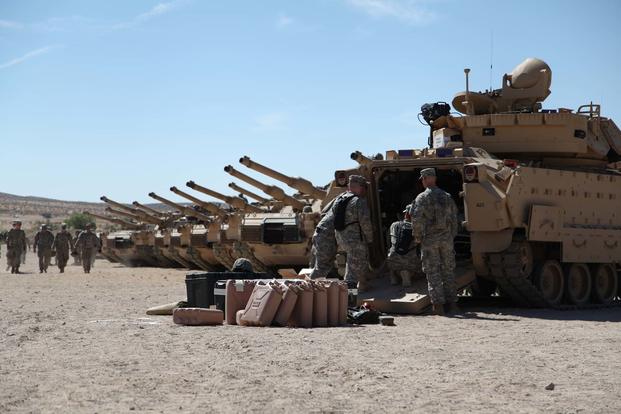The head of the National Guard Bureau told Congress Wednesday not to expect training and deployment schedules to slow down as the Army Guard is intensifying efforts to prepare its armored brigades for war.
The Army National Guard has been adjusting the training schedule for its five armored brigade combat teams to satisfy the Army's intention to deploy them like active combat units, General Joseph L. Lengyel, chief of the National Guard Bureau, told lawmakers at a May 24 hearing before the House Appropriations Committee's Defense Subcommittee.
The hearing occurred a day after the Army unveiled its budget request for fiscal 2018. The service's base budget of $137.2 billion is $3.9 billion more than the recently enacted fiscal 2017 budget.
Part of the increase will pay for 19 annual combat training center rotations at either the National Training Center at Fort Irwin, California, or at the Joint Readiness Training Center at Fort Polk, Louisiana. The active Army will do 15 rotations a year and the Guard four.
"What is new is the United States Army has decided to increase the training available to the brigade combat teams," Lengyel said. "We are going to from two combat training center rotations a year to four."
Rep. Betty McCollum, D-Minn., said she was concerned that the operating tempo for part-time soldiers "has been drastically increased for the number of training days for the National Guard soldiers" from 39 to as many as 60.
"We know this increase in training days is important ... but it is putting more and more of a burden on the quality of life for soldiers, the units and their families. I am concerned; the Minnesota National Guard is concerned about long-term retention in these brigades.
"How are you going to be monitoring this?" she added.
"We are aware of this issue and this is one of the things as the chief of the National Guard Bureau that I track closely," Lengyel said. I worry about the business model of the National Guard which means our soldiers and airmen have a civilian life and military life ... If he or she is forced to make a choice, then I know which one they will pick and most likely I will lose that soldier or airman."
Some soldiers have already decided that they can't support the increased demands and they will change military occupational specialties, or MOSs, Lengyel said.
As far as monitoring the effort, Lengyel said "this is a leadership issue; we have to watch the people and have personal engagement on my part on the adjutant generals' part, on the commander's part with making sure that the schedules that we give these soldiers are predictable. And that we let the employers know that you can count on these soldiers and that these increased training times actually result in a deployment for the soldiers at the end."
Otherwise, Lengyel said, employers may not understand why they should endure having employees be away from work for extended time if a deployment doesn't come at the end this more intense training period.
"The plan is for the Army to use these forces and deploy them," Lengyel said. "This is the first cycle of this.
"There will be a change as this goes forward, and we are going to have to work with the employers on the numbers ... so we don't lose them."
McCollum thanked Lengyel, but cautioned him that "this isn't about leadership to put up and be quiet about it. This is also about leadership to see if we need to go back and review and figure out how these folks are not only trained but deployed in the future."
Rep. Harold Rogers, R-Ky., asked how the Guard will use the additional 1,000 soldiers that Congress authorized as part of the fiscal 2017 budget.
The National Guard was on a glide path to have 335,000 soldiers, but Congress intervened and stopped that reduction at 342,000 last year, Lengyel said.
"We are able to grow it back by 1,000 to 343,000 this year," Lengyel said. "Our intent is to take that additional manpower, and as I talked about it on the five armored brigade combat teams, we are going to place it against and increase the readiness of these high-demand, operationally deploying units."
"One of the concerns of the increased manpower is "we didn't get the increased full-time support back with it," Lengyel said.
"We took the full-timers out all the way down to 335,000, and we built the Army Guard back up to 343,000, but they are part-time billets and not full-time billets and that hurts our ability to generate the force quickly and keep it ready."
-- Editor's note: This story has been updated to correct the number of training days referenced by the congresswoman in the sixth paragraph.
-- Matthew Cox can be reached at matthew.cox@military.com.
























